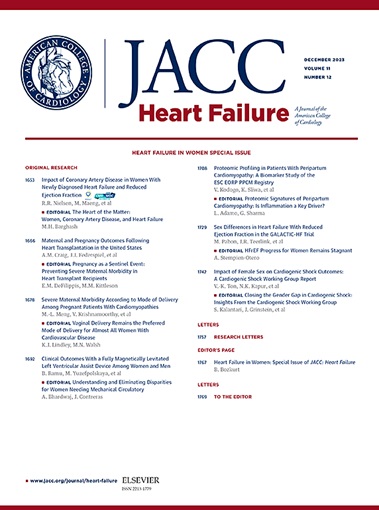术前临时机械循环支持对LVAD持久预后的影响
IF 11.8
1区 医学
Q1 CARDIAC & CARDIOVASCULAR SYSTEMS
引用次数: 0
摘要
背景:越来越多接受持久左心室辅助装置(LVAD)植入的患者需要临时机械循环支持装置(tMCS)的支持。在当代,tMCS对lvad后预后的影响描述甚少。目的:本研究旨在确定在胸外科学会Intermacs(机械辅助循环支持机构间注册)数据库支持下LVAD植入患者的特征和结果。作者假设死亡率和不良事件将根据tMCS类型而变化。方法纳入2020年至2024年接受全磁悬浮LVAD植入的成年患者(Intermacs profiles 1-3)。分析的主要结果是1年和2年的死亡率和中风率。结果比较无tMCS、主动脉内球囊泵(IABP)、高流量微轴流泵(HF-MP)和静脉-动脉体外膜氧合的队列。采用多变量比例风险模型确定与患者生存相关的术前和围手术期特征。采用倾向评分匹配(PSM)分析比较HF-MP和无tMCS。结果5787例LVAD患者符合纳入标准;LVAD植入时tMCS支持3863例(66.7%)。在研究期间,HF-MP的使用显著增加(19.1%至35.1%,P < 0.001),而IABP的使用则下降(41.2%至27.3%,P < 0.001)。1年和2年的总生存率分别为82.9%和77.9%。体外膜氧合患者的1年和2年生存率最低(70.6%和67.1%),而IABP(85.7%和81.2%)和HF-MP(82.9%和77.5%)患者的生存率与未接受tMCS治疗的患者相当(分别为82.4%和77%)。在调整后的多变量模型中,与无tMCS相比,HF-MP (HR: 0.71 [95% CI: 0.59-0.84]; P = 0.001)和IABP (HR: 0.74 [95% CI: 0.63-0.86]; P = 0.001)与生存率的提高相关。在倾向评分匹配队列中,HF-MP组1年和2年生存率分别为85.2%对80.5%,79.9%对74.3%,而未接受tMCS治疗组1年卒中自由率相似,分别为93.1%和93.9% (P = 0.33)。结论越来越多的持久LVAD患者在植入时得到tMCS的支持。与不使用tMCS相比,使用HF-MP和IABP可提高生存率和卒中等效率。本文章由计算机程序翻译,如有差异,请以英文原文为准。
Impact of Preoperative Temporary Mechanical Circulatory Support on Durable LVAD Outcomes
Background
An increasing number of patients undergoing durable left ventricular assist device (LVAD) implantation are supported with temporary mechanical circulatory support (tMCS) devices. The impact of tMCS on post-LVAD outcomes in the contemporary era is poorly described.
Objectives
This study aims to define characteristics and outcomes in patients undergoing LVAD implantation while on tMCS support from the Society of Thoracic Surgeons Intermacs (Interagency Registry for Mechanically Assisted Circulatory Support) database. The authors hypothesized that mortality rates and adverse events would vary based on tMCS type.
Methods
Adult patients who underwent implantation of a fully magnetically levitated LVAD from 2020 to 2024 as Intermacs profiles 1-3 were included. Primary outcomes analyzed were 1- and 2-year mortality and rates of stroke. Outcomes were compared in cohorts with no tMCS, intra-aortic balloon pump (IABP), high-flow micro-axial flow pump (HF-MP), and veno-arterial extracorporeal membrane oxygenation. A multivariable proportional hazards model was used to determine preoperative and perioperative characteristics associated with patient survival. A propensity score matching (PSM) analysis was performed to compare HF-MP with no tMCS.
Results
A total of 5,787 LVAD patients met inclusion criteria; 3,863 (66.7%) were supported on tMCS at the time of LVAD implantation. The use of the HF-MP increased significantly over the study period (19.1% to 35.1%, P < 0.001) whereas the use of IABP decreased (41.2% to 27.3%, P < 0.001). Overall patient survival was 82.9% and 77.9% at 1 and 2 years, respectively. Patients on extracorporeal membrane oxygenation had the lowest 1- and 2-year survival (70.6% and 67.1%) whereas patients on IABP (85.7% and 81.2%) and HF-MP (82.9% and 77.5%) had survival rates comparable to patients without tMCS therapy (82.4% and 77%, respectively). In the adjusted multivariable model, both HF-MP (HR: 0.71 [95% CI: 0.59-0.84]; P = 0.001) and IABP (HR: 0.74 [95% CI: 0.63-0.86]; P = 0.001) were associated with improved survival compared to no tMCS. In the propensity score matching cohort, rates of survival at 1 and 2 years were 85.2% vs 80.5%, respectively, and 79.9% vs 74.3% for HF-MP, respectively, vs no tMCS therapy (P = 0.009), whereas rates of freedom from stroke at 1 year were similar at 93.1% and 93.9% (P = 0.33), respectively.
Conclusions
An increasing number of patients undergoing durable LVAD are supported on tMCS at the time of implantation. Use of HF-MP and IABP were associated with improved survival and equivalent rate of stroke compared to no tMCS.
求助全文
通过发布文献求助,成功后即可免费获取论文全文。
去求助
来源期刊

JACC. Heart failure
CARDIAC & CARDIOVASCULAR SYSTEMS-
CiteScore
21.20
自引率
2.30%
发文量
164
期刊介绍:
JACC: Heart Failure publishes crucial findings on the pathophysiology, diagnosis, treatment, and care of heart failure patients. The goal is to enhance understanding through timely scientific communication on disease, clinical trials, outcomes, and therapeutic advances. The Journal fosters interdisciplinary connections with neuroscience, pulmonary medicine, nephrology, electrophysiology, and surgery related to heart failure. It also covers articles on pharmacogenetics, biomarkers, and metabolomics.
 求助内容:
求助内容: 应助结果提醒方式:
应助结果提醒方式:


